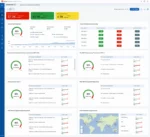
Zero trust is broken. Not because it’s a bad idea, but because most organizations are applying it wrong. If your security still depends on humans to approve access requests, verify identities, and respond to threats, you’re already behind. Zero trust’s core principle—trust no one, verify everything—breaks down when manual processes are too slow, error-prone, and inefficient.
If your zero-trust framework relies on static rules and human approval, it’s time to upgrade your strategy. Zero trust automation is the only way to make this approach scalable and effective. Humans can’t keep up with today’s security demands. You need automation to handle decisions faster and more accurately.
Manual Zero Trust Is a Security Risk You Can’t Afford
Manual zero trust is slow, prone to errors, and impossible to scale. Every time your security team has to manually approve access or analyze activity, your system slows down. This creates bottlenecks that weaken security and drag down productivity.
Worse, humans make mistakes—especially under pressure. Your team might grant too much access, miss suspicious behavior, or take too long to act. These inefficiencies are a liability in today’s fast-moving threat landscape. If you’re serious about security, automation is the only solution.
Consider Capital One’s 2019 data breach. The breach stemmed from a misconfigured firewall in their AWS cloud environment, which allowed an attacker to access sensitive customer data. Had automated configuration monitoring been in place, the misconfiguration could have been detected earlier, reducing the likelihood of the breach going unnoticed for so long. By automating the detection of misconfigurations and access anomalies, Capital One might have contained the attack much sooner.
Automate Zero Trust Now—Or Risk Falling Behind
Zero trust automation allows you to apply the principles of zero trust—constant verification and least-privilege access—without slowing down your business. Here’s why automation is the only way to make zero trust work:
- Instant Access Decisions: With automation, decisions are based on real-time data—like location, behavior, and risk level—to make access decisions instantly. Many organizations that have adopted automated access controls report much faster approval times, allowing employees to work efficiently without compromising security.
- Continuous Verification: Zero trust isn’t a one-time check. It requires ongoing verification. Automation handles this by constantly monitoring user behavior and adjusting access in real time. If something looks suspicious, the system automatically responds— no human intervention needed.
- Consistent Enforcement: Manual processes are inconsistent. Different people enforce policies differently, leading to gaps in security. Automation guarantees uniform enforcement across your entire organization, reducing human error and ensuring compliance.
- Freeing Up Security Teams: Automating zero trust doesn’t just improve security—it frees up your security team. No more time wasted on repetitive tasks like approving access or responding to low-level threats. Your team can focus on bigger risks and strategic priorities.
Bottom line: automation scales, humans don’t. Your security must evolve to meet the pace of modern threats. That means embracing automation.
Why Fear of Losing Control Is Holding You Back
Many companies resist automating zero trust because they fear losing control. They worry automation won’t make the right decisions or that they’ll lose visibility into what’s happening. This fear keeps companies stuck in outdated, inefficient systems.
But this fear is misplaced. Automating trust doesn’t mean losing control—it means gaining faster, more precise control. Automation doesn’t get distracted or make emotional decisions. It acts instantly, based on real-time data. You’re not losing control—you’re gaining precision.
Automation also offers greater visibility. Dashboards that show you every access request, threat, and response as it happens offer more transparency than manual processes ever could. Sticking with manual systems isn’t giving you more control—it’s slowing you down and increasing your risk.
Step-by-Step: How to Automate Zero Trust Successfully
Transitioning to automation doesn’t require overhauling your entire system overnight. Here’s how to start automating zero trust in a practical, step-by-step way:
- Automate Access Controls: Use tools powered by automation to manage access in real time. These tools adjust access based on factors like location, behavior, and device, ensuring that only the right people get through. For example, if an employee logs in from an unusual location, the system can trigger multi-factor authentication automatically.
- Automate Incident Response: Automate routine security tasks like isolating compromised devices or blocking suspicious IP addresses. SOAR (Security Orchestration, Automation, and Response) platforms handle these tasks quickly, allowing your security team to focus on more serious threats.
- Continuous Monitoring: Implement automated systems that monitor user activity around the clock. This allows your system to adjust access dynamically and respond to threats without needing human intervention. Real-time monitoring is crucial in industries like finance and healthcare, where sensitive information must be constantly protected.
- Learn and Adapt: Automation isn’t a “set it and forget it” system. Use past data to make your automated systems smarter and more effective over time.
The Future of Security: Zero Trust Must Be Automated
Zero trust, as implemented today, is ineffective. Manual processes are too slow, too prone to error, and too inconsistent to handle modern threats. If you want zero trust to actually work, you need to automate it. Automated systems make decisions faster, more consistently, and with fewer mistakes than humans ever could.
In the coming years, zero trust automation will become the standard for security-conscious companies. Those that embrace automation will secure their systems and scale their operations without sacrificing control. Companies that rely on outdated, manual processes will be left behind, struggling to keep up with the growing complexity of cyber threats. It’s time to stop slowing down your security with human-dependent processes. Automate trust, and let your systems make the fast, accurate decisions that modern security demands.








